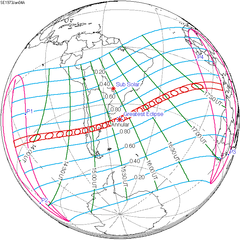January 1982 lunar eclipse
| Total eclipse | |||||||||||||||||
| Date | 9 January 1982 | ||||||||||||||||
|---|---|---|---|---|---|---|---|---|---|---|---|---|---|---|---|---|---|
| Gamma | −0.29158 | ||||||||||||||||
| Magnitude | 1.33103 | ||||||||||||||||
| Saros cycle | 124 (47 of 74) | ||||||||||||||||
| Totality | 77 minutes, 39.5 seconds | ||||||||||||||||
| Partiality | 203 minutes, 51.8 seconds | ||||||||||||||||
| Penumbral | 319 minutes, 13.4 seconds | ||||||||||||||||
| |||||||||||||||||
A total lunar eclipse took place on Saturday, 9 January and Sunday, 10 January 1982, the first of three lunar eclipses in 1982. The Moon was plunged into darkness for 1 hour and 17 minutes 39.5 seconds, in a deep total eclipse which saw the Moon 33.103% of its diameter inside the Earth's umbral shadow. The visual effect of this depends on the state of the Earth's atmosphere, but the Moon may have been stained a deep red colour. The partial eclipse lasted for 3 hours and 24 minutes in total.[1]
Visibility
[edit]It was completely visible over Europe, Africa, Asia and Australia, seen rising over North Atlantic Ocean, and setting over North Pacific Ocean.[citation needed]
Related eclipses
[edit]Eclipses in 1982
[edit]- A total lunar eclipse on 9 January.
- A partial solar eclipse on 25 January.
- A partial solar eclipse on 21 June.
- A total lunar eclipse on 6 July.
- A partial solar eclipse on 20 July.
- A partial solar eclipse on 15 December.
- A total lunar eclipse on 30 December.
There were seven eclipses in 1982, the maximum possible, including 4 partial solar eclipses: 25 January, 20 July, June 21, and 15 December.
Lunar year series
[edit]| Lunar eclipse series sets from 1980–1984 | ||||||||
|---|---|---|---|---|---|---|---|---|
| Descending node | Ascending node | |||||||
| Saros | Date Viewing |
Type Chart |
Gamma | Saros | Date Viewing |
Type Chart |
Gamma | |
| 109 | 1980 Jul 27
|
Penumbral
|
1.41391 | 114 | 1981 Jan 20
|
Penumbral
|
−1.01421 | |
| 119 | 1981 Jul 17
|
Partial
|
0.70454 | 124 | 1982 Jan 09
|
Total
|
−0.29158 | |
| 129 | 1982 Jul 06
|
Total
|
−0.05792 | 134 | 1982 Dec 30
|
Total
|
0.37579 | |
| 139 | 1983 Jun 25
|
Partial
|
−0.81520 | 144 | 1983 Dec 20
|
Penumbral
|
1.07468 | |
| 149 | 1984 Jun 13
|
Penumbral
|
−1.52403 | |||||
| Last set | 1980 Aug 26 | Last set | 1980 Mar 13 | |||||
| Next set | 1984 May 15 | Next set | 1984 Nov 08 | |||||
Tritos
[edit]- Preceded: Lunar eclipse of February 10, 1971
- Followed: Lunar eclipse of December 9, 1992
Tzolkinex
[edit]- Preceded: Lunar eclipse of November 29, 1974
- Followed: Lunar eclipse of March 9, 1988
Half-Saros cycle
[edit]A lunar eclipse will be preceded and followed by solar eclipses by 9 years and 5.5 days (a half saros).[2] This lunar eclipse is related to two annular solar eclipses of Solar Saros 131.
| January 4, 1973 | January 15, 1991 |
|---|---|

|

|
See also
[edit]Notes
[edit]- ^ Hermit Eclipse: Saros cycle 124
- ^ Mathematical Astronomy Morsels, Jean Meeus, p.110, Chapter 18, The half-saros
External links
[edit]- 1982 Jan 09 chart Eclipse Predictions by Fred Espenak, NASA/GSFC




